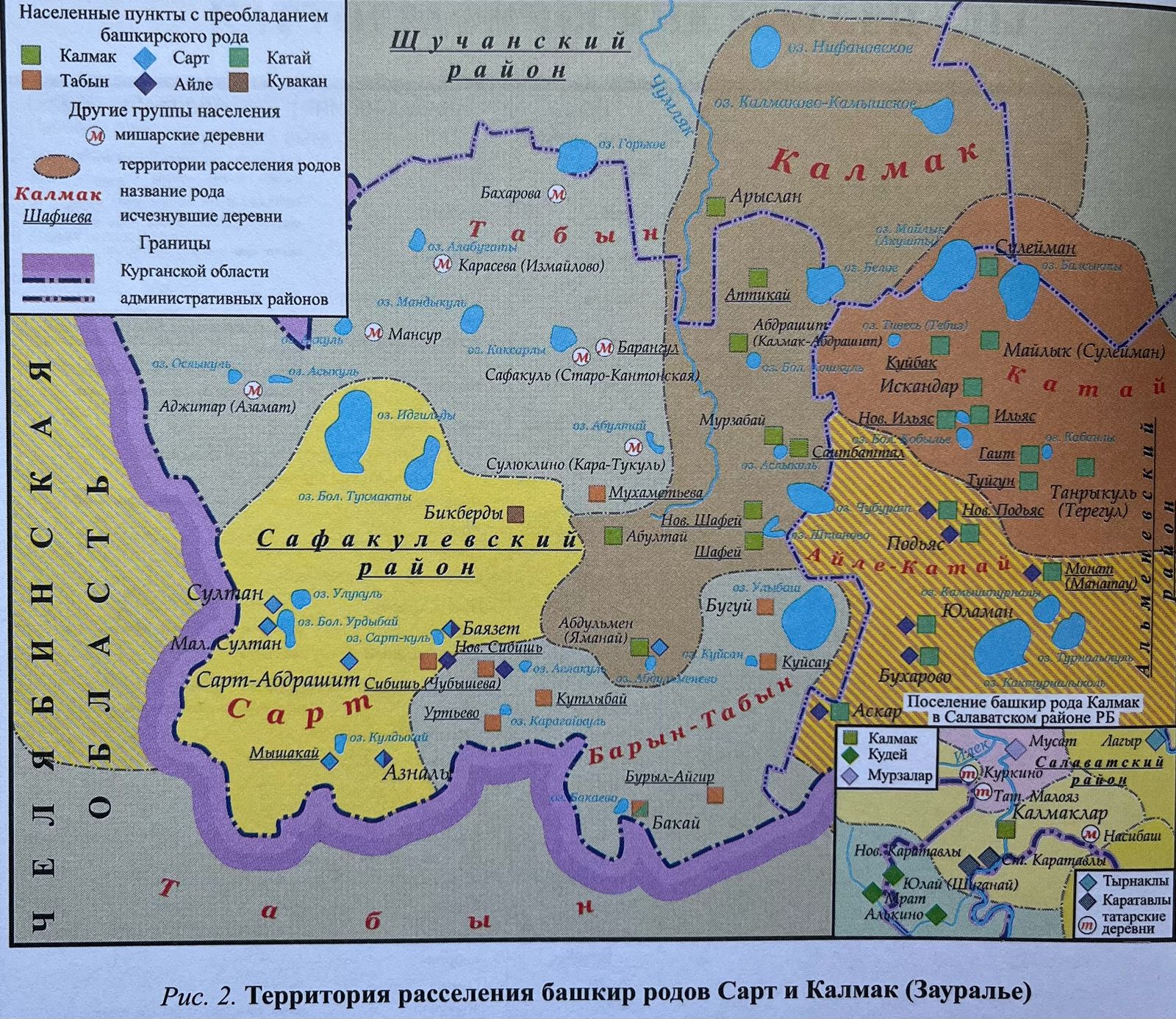Specifics of the incorporation of Kalmyks (Kalmaks) within the Bashkirs and ethno-genetic links with Mongolian-speaking peoples
Research Article
Keywords:
Kalmak volost, “Ayukinsky Kalmyks”, Kalmyks (Kalmaks), Bashkirs, assimilation, genetic research, Y chromosomeAbstract
The process of incorporation within the Bashkirs took place not only through adoption but also through the formation of separate clan volosts by descendants of other ethnic groups, which is illustrated by the existence of the Oirat, Sart, Merkit, Kalmak, and other Bashkir volosts. A number of Bashkir tribal clans (tribes) include subdivisions (ara, naҫel) with the name ҡalmaҡ. Aim and objectives: the formation of the Kalmyk (Kalmak) clan within the Bashkirs and their ethno-genetic ties. In connection with the specified purpose, it is planned to carry out a complex analysis of the existing historiography on the subject of the realised research, to compare its materials with the data of ethno-genetic researches, to consider the questions of transformation of ethno-cultural identity and demographic development of Kalmyks (Kalmaks). Materials and methods: The main methods of the research were comparative-historical and retrospective analyses. The authors analysed a wide range of sources of already published scientific works and information from archives, including from the fund ‘Kalmyk cases of the Embassy Order’ of the Russian State Agency for Data Analysis and Data from regional archives. Results: the Oirats, who formed a separate Uirat (Oirat) volost in the Bashkir Trans-Urals in the XIII-XIV centuries, lost their compactness of residence due to a number of reasons and were completely incorporated into other clan groups of Bashkirs. They were not ancestors of the Bashkirs of the Kalmak clan (Kalmakskaya volost). Based on archival materials, an attempt is made to trace the fates of the families of Kalmyk origin - the founders of the Kalmak volost in the Trans-Ural region. The demographic development of the Kalmak clan group in the Trans-Ural region is analysed and information about other Kalmyk groups within the Bashkirs is noted. The ethnogenetic kinship of Bashkirs of Kalmyk descent with various ethnographic groups of Mongolian-speaking peoples and Kazakhs is analysed by comparing the obtained materials of genetic studies (on the Y-chromosome). Conclusions: Kalmyks settled among the Bashkirs acquired the rights and duties of equal members of the Bashkir communities. In the descendants of the Kalmak family, the genetic line Nlcl-F4205 haplogroup Nlc1-M178 is represented in the Bashkirs with the highest frequency, and the geographically distant populations of Mongol-Tsaatan (more than half of this group are carriers of this genetic line), some part of the Tuvinian-Tozhin, Mongol-Derbet, Mongol-Togout, and Kalmyk-Khoshuut are located on it. The descendants of Kalmyks incorporated into the southern and southeastern Bashkir tribes - Burzyan, Yurmaty, Kypchak, Usyargen, and Tangaur - are also of Kalmyk origin.
Downloads
References
Balinova N., Post H., Kushniarevich A., Rodrigo Flores J., Karmin M., Sahakyan H., Reidla M., Metspalu Е., Litvinov S., Dzhaubermezov M., Akhmetova V., Khusainova R., Endicott Ph., Khusnutdinova E., Orlova K., Bakaeva E., Khomyakova I., Spitsina N., Zinchenko R., Villems R.,
Rootsi S.. Y-chromosomal analysis of clan structure of Kalmyks, the only European Mongol people, and their relationship to Oirat-Mongols of Inner Asia. European Journal of Human Genetics. European Journal of Human Genetics. 2019. Vol.27(9), pp. 1466–1474.
Азнабаев Б.А. Башкирское общество в XVII – первой трети XVIII в. Уфа: РИЦ БашГУ, 2016. 370 с.
Асфандияров А.З. История сел и деревень Башкортостана. Кн.9. Уфа: Китап, 2001. 304 с.
Дэн В.Э. Население России по пятой ревизии. Подушная подать в XVIII веке и статистика населения в конце XVIII века. В. Э. Ден. - Москва. 1902. - 2 т. - Отт. из Учен. записок имп. Моск. ун-та. Юрид. фак.; Вып. 21. 319 с.
История башкирских родов. Сарт и Калмак. Том 27. С. И. Хамидуллин, Б.А. Азнабаев, И.Р. Саитбатталов, И.3. Султанмуратов, Р.Р. Шайхеев, Р.Р. Асылгужин, В.Г. Волков, А.А. Каримов, А.М. Зайнуллин. Уфа: ИИЯЛ УНЦ РАН; Китап, 2017. 456 с.
История башкирских родов. Салъют, Терсяк, Сынрян, Бикатин, Сырзы, Шуран. Том 19. С. Хамидуллин и др. Уфа: ИИЯЛ УНЦ РАН: Китап. 2016. 584 с.
Кузеев Р. Происхождение башкирского народа. Этнический состав, история расселения. Уфа: ДизайнПолиграфСервис. 2010. 560 с.
Кузеев Р., Бикбулатов Н., Шитова С. Зауральские башкиры (этнографический очерк быта и культуры конца XIX – начала XX вв.). В: Археология и этнография Башкирии. I. Уфа, БФАН СССР. 1962. С. 171–267.
Надршин Ф. Башкирско-калмыкские взаимоотношения в XVII–XVIII вв. В: Башкиры Оренбуржья: История, традиция, культура. Оренбург. 2013. С.55–65.
Рычков П. Топография Оренбургской губернии. Уфа: Китап. 1999. 312 с.
Самигулов Г. Формирование тюркской группы калмак и Сарт-Калмакской волости в Южном Зауралье XVIII века. Научный диалог. 2018. No.9, с.275–294. https://doi. org/ 10.24224/2227-1295-2018-9-275-294
Самигулов Г. Аюкинские калмыки: к истории этнической группы. Вестник Челябинского государственного университета. История. 2015. Вып.64, no.14(369), с.45–50.
Тоган А. История башкир. [перевод с турецк. А.М. Юлдашбаева; авт. вступ. статей А.М. Юлдашбаев, И. Тоган] (перевод с турецкого). Уфа. Китап. 2010. 352 с.
Туған Ә.В. Бөгөнгө төркиле Төркөстан һәм яҡын тарихы. Көнбайыш һәм Төньяҡ Төркөстан. Өфө. Китап. 2014. 276 c.
Этнокультурная история населения Сафакулевского района (с древнейших времен до начала XX века). Под ред. Д.Н. Маслюженко. Курган: Изд-во Курганского гос. ун-та. 2021. 102 с.
Янгузин Р., Томашевская Н. «Новобашкиры»: численность, расселение (XVIII – середина XIX века). В: Демография башкирского народа: прошлое и настоящее: Материалы межрегиональной научно-практической конф., посвящ. II Всемир. курултаю башкир, 23 апреля 2002 г. с.49-55.

Downloads
Published
Issue
Section
License
Copyright (c) 2025 R. Asilguzhin, E. Khabibullin

This work is licensed under a Creative Commons Attribution-NonCommercial-NoDerivatives 4.0 International License.


